The official plaque reads:
The North Star Powerhouse, built by A. D. Foote in 1895, was the first complete plant of its kind. Compressed air, generated by Pelton water wheels, furnished power for the entire mine operation. The 30-foot Pelton wheel was the largest in the world, and was in continuous use for over 30 years.
At the North Star you will find displays of mining
equipment and artifacts from the 1880's awaiting visitors. On display is the
largest Pelton Wheel ever constructed and used to generate power for mining
operations. You will also see the largest operational Cornish pump.The museum
has a secluded picnic area; just walk across the bridge that crosses Wolf Creek
and sit alongside this rushing creek where lunch can be enjoyed at picnic
tables.
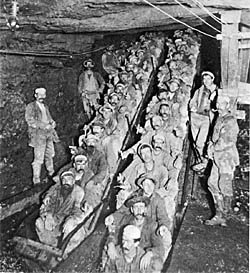
Placer gold was first found in Wolf Creek in 1848 shortly after Marshall's
discovery at Coloma. The earliest mining was done by David Stump and two
companions who came from Oregon. The shallow placers were rich but were
exhausted quickly. Gold-bearing quartz was discovered at Gold Hill in 1850 and
soon afterward at Ophir, Rich, and Massachusetts Hills. Quartz mining soon
developed into a major industry that was to last more than 100 years. The Gold
Hill and Allison Ranch were the leading lode mines during the 1850s. Mining was
curtailed somewhat during the Comstock rush of 1859-65, but the mines were
productive again in the late 1860s. The camp declined in the 1870s, and by 1880
only the Empire and Idaho mines were active. In 1884 the North Star mine was
reopened and activities increased; the North Star, Empire, Idaho-Maryland,
Pennsylvania, and W.Y.O.D. all were highly productive. B ' v 1900, the
Idaho-Maryland mine had yielded a total of $12.5 million. From 1900 to 1925, the
North Star and Empire mines were the largest producers, the Idaho-Maryland
having been idle in 1901-19. By 1928, the North Star had had a total output
valued at $33 million.
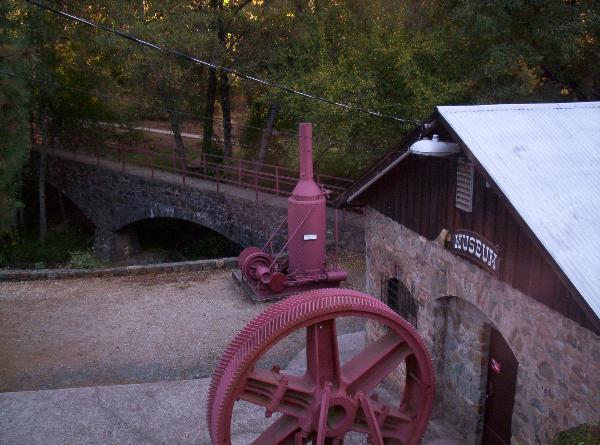
In the earliest days of underground mining everything not driven by muscle of
man or mule was run by steam engines. Gold mining was no longer a business for
loners; it now took a company with resources to sink the shafts and dig for the
hidden yellow metal.
At the North Star Mine in Grass Valley the steam was generated by wood-fired
engines. Surrounding forests were being destroyed to provide firewood for the
steam boilers.
When Lester Pelton came down from nearby Camptonville in 1878, he brought a
strange implement to George Allen, owner of the Miners' Foundry in Nevada City,
and set up a demonstration. Pelton had brought a bicycle wheel with tin cups on
it. He claimed to have invented a water wheel that would revolutionize the use
of water for power. His secret was water-catching buckets split down the middle
into two half-cups.
After the demonstration, an impressed Allen agreed to manufacture the new
design. First he built a single cast iron wheel and used it to run all the
machines in the foundry. Mine owners who came in to buy parts for their stamp
mills were shown the wheel at work.
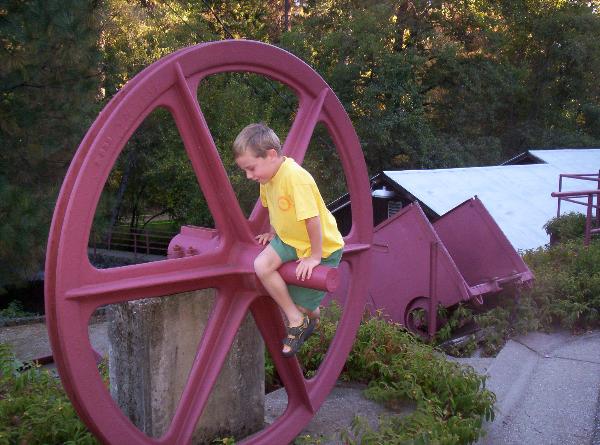
The mine owners saw Wheel One in operation and got the idea. They were
running out of trees to burn and saw an approaching end to steam power in the
mines.
Soon after Wheel One went into operation, in 1895, an 18-foot water wheel was
created to run machinery at the Massa-chusetts Hill Mine. At the time it was the
biggest Pelton Wheel ever built. Water rushed through a cast iron pipe, then
through a nozzle, turning the wheel, producing compressed air. The plant was the
brainchild of Arthur De Wint Foote, a civil engineer sent to Grass Valley by the
mine owners.
The Pelton Company had guaranteed that the 10,000 pound wheel would operate
at 75 percent efficiency, filling a six-inch compressed air supply line that
powered the mine. Foote gave the completed installation a rating of 90 percent.
The system worked so well that it won Foote the position of superintendent at
the North Star Mine. In 1898 its owners agreed to put in a 30-foot wheel to run
equipment in at the North Star's central shaft. It was the biggest Pelton Wheel
in the world, developing 1,000 horsepower at 65 revolutions a minute, its
buckets travelling at 72 miles an hour.
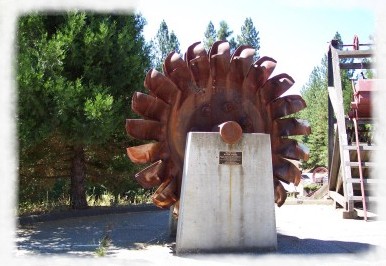
The 18-footer powered two air compressors; the 30-foot wheel drove four newly
designed compressors, delivering ninety pounds of air pressure 2,000 feet to the
North Star central shaft. In the mines the drills were air powered, and the air
was used for ventilation.
As the Grass Valley mines switched from wood-fired steam power to water
wheels and compressed air, another power source was vying for attention:
electricity.
Before recommending Pelton Wheels and compressed air for the North Star Mine
powerhouse A.D. Foote advised the owner that the insulation on the electrical
equipment was insufficient for the wet conditions in Nevada County mines.
Electricity was coming, but it was premature. It would be 35 years before the
mine was electrified.
When declining gold prices in the 1950s brought an end to mining operations
in the Grass Valley area, Pelton Wheels were propelled into obscurity by a 344
percent rise in the cost of water. The deserted powerhouse fell to other uses.
Local kids would get into the building and push the big Pelton wheel around,
riding it like a Ferris wheel. The big thrill was standing on the braces,
holding tight, and going over the top. While their sport may have been
dangerous, the kids didn't do nearly the damage to the old powerhouse that the
salvage people did.
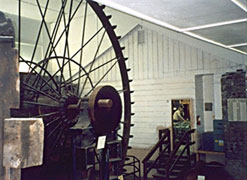
Much of the historic iron went to the scrap piles before help arrived to
preserve the remainder. The giant 30-foot wheel was saved by Phoebe Cartwright,
a Grass Valley resident who raised $2,000 to buy the wheel back from the scrap
heap.
In 1961 the mining company deeded slightly more than an acre of land,
containing the wheel and the old powerhouse, to the City of Grass Valley for the
North Star Powerhouse Mining Museum, where you can still see "Wheel
One," the first commercially manufactured Pelton Wheel, about the size of a
car tire, an invention that changed gold mining forever
References: Tales
from the Mines, Gold
Rush Stories, Nevada
County History,